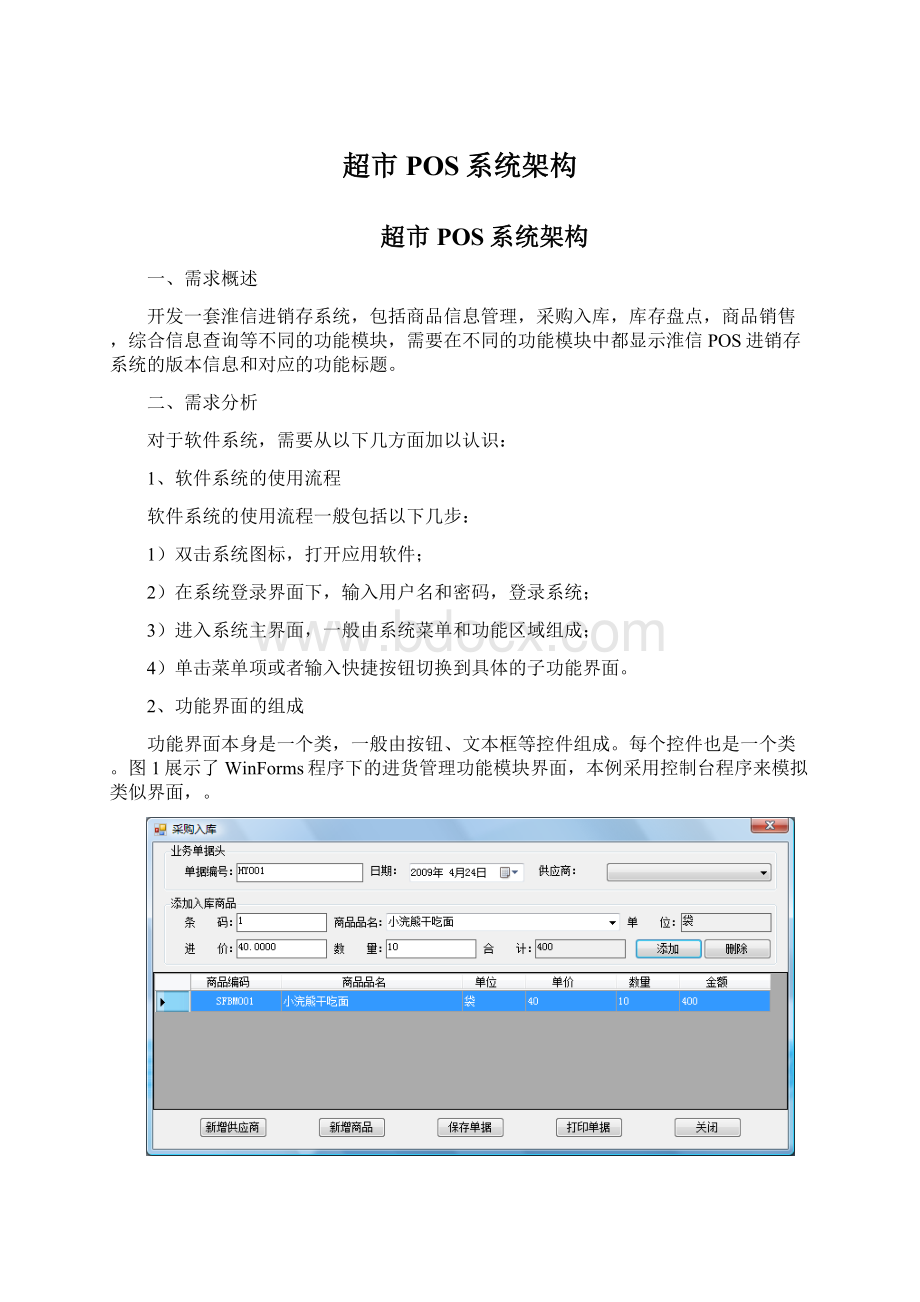超市POS系统架构.docx
《超市POS系统架构.docx》由会员分享,可在线阅读,更多相关《超市POS系统架构.docx(19页珍藏版)》请在冰豆网上搜索。

超市POS系统架构
超市POS系统架构
一、需求概述
开发一套淮信进销存系统,包括商品信息管理,采购入库,库存盘点,商品销售,综合信息查询等不同的功能模块,需要在不同的功能模块中都显示淮信POS进销存系统的版本信息和对应的功能标题。
二、需求分析
对于软件系统,需要从以下几方面加以认识:
1、软件系统的使用流程
软件系统的使用流程一般包括以下几步:
1)双击系统图标,打开应用软件;
2)在系统登录界面下,输入用户名和密码,登录系统;
3)进入系统主界面,一般由系统菜单和功能区域组成;
4)单击菜单项或者输入快捷按钮切换到具体的子功能界面。
2、功能界面的组成
功能界面本身是一个类,一般由按钮、文本框等控件组成。
每个控件也是一个类。
图1展示了WinForms程序下的进货管理功能模块界面,本例采用控制台程序来模拟类似界面,。
图1采购入库功能界面
软件开发的整体思路是由简单到复杂,层层递进。
目前的任务是在整体上对进销存系统有一个了解,稳扎稳打,为项目的开发打下语言基础。
在具体编码之前,一定要先明确自己要做什么,对于本任务,可按如下步骤来操作:
1、建立登录界面类,要求用户输入用户名和密码(假设均为admin);
2、建立主界面类,接收用户输入,根据输入菜单名称的不同,显示相应的功能菜单;
3、建立各个功能界面类,接收用户输入,返回主界面。
各个类之间的关系如图2所示:
输入0
图2各界面间关系
三、实现过程
1、创建名为HcitPosSys的C#控制台应用程序;
2、新建名为SoftwareInfo的类,用来显示软件版本、版权信息等,代码如下:
usingSystem;
usingSystem.Collections.Generic;
usingSystem.Text;
namespaceHcitPosSys
{
//此处用静态类声明软件版本信息,注意:
静态类不可以实例化,并且类成员都需要声明static
publicstaticclassSoftWareInfo
{
publicstaticstringuserName;//软件当前用户
publicstaticvoidShowHeader()
{
Console.WriteLine("======================================================");
Console.WriteLine("淮信HcitPos进销存管理系统版本号:
V1.0.2009.4");Console.WriteLine("======================================================");
}
publicstaticvoidShowFooter()
{
Console.WriteLine();
Console.WriteLine("您好,{0},当前系统时间为{1}",userName,DateTime.Now);
Console.WriteLine("版权所有:
2009-2010联系方式:
12345678");
Console.WriteLine();
}
}
}
3、新建名为FrmLogin的类,(Form即界面的英文表述,此处用Frm前缀表示这是一个界面类),逻辑代码如下所示,具体功能实现参见注释:
usingSystem;
usingSystem.Collections.Generic;
usingSystem.Text;
namespaceHcitPosSys
{
publicclassFrmLogin
{
privatestringuserName;
privatestringpassword;
//默认构造函数
publicFrmLogin()
{
}
//1.用户名和密码显示区,空了行才要求用户输入用户名和密码,主要是为了界面美观
//本功能比较独立,所以单独放在一个方法里,这就是模块化编程的思想
privatevoidShowLoginInfo()
{
for(inti=0;i<5;i++)
Console.WriteLine();
Console.Write("用户名:
");
userName=Console.ReadLine();
Console.Write("密码:
");
password=Console.ReadLine();
}
//2.验证用户名和密码功能,供主程序循环调用
publicboolValidateUserInfo()
{
//1.访问数据库来获取用户名、密码信息,模拟为admin,admin
//2.校验是否合法
if(userName=="admin"&&password=="admin")
{
//将用户名信息保存在静态字段中
SoftWareInfo.userName=userName;
returntrue;
}
returnfalse;
}
//3.显示登录界面
publicvoidShow()
{
SoftWareInfo.ShowHeader();
ShowLoginInfo();
}
}
}
注意SoftWareInfo.userName=userName;这句代码,这样在其他界面中也能访问到登录的用户信息。
4、双击“Program.cs”文件,修改该文件为:
usingSystem;
usingSystem.Collections.Generic;
usingSystem.Text;
namespaceHcitPosSys
{
classProgram
{
staticvoidMain(string[]args)
{
FrmLoginfrm=newFrmLogin();
frm.Show();
}
}
}
按键运行程序,界面如图4.11所示:
图4.11登录界面
注意,本步骤体现了软件开发流程,在完成一个功能类后,应该首先测试该功能是否可用,当代码出错的时候,方便发现错误和解决错误,这也是一个层次递进的开发过程。
5、添加“FrmMain”类(主界面类),代码如下:
usingSystem;
usingSystem.Collections.Generic;
usingSystem.Text;
namespaceHcitPosSys
{
publicclassFrmMain
{
//1.显示主界面
publicvoidShow()
{
SoftWareInfo.ShowHeader();
for(inti=0;i<5;i++)
{
Console.WriteLine();
}
Console.WriteLine("请选择子功能模块:
\n1.商品信息维护\n2.采购入库\n3.库存盘点\n4.商品销售\n5.综合查询");//\n的作用为换行
for(inti=0;i<5;i++)
{
Console.WriteLine();
}
SoftWareInfo.ShowFooter();
}
//2.获取用户输入
publicintGetUserInput()
{
returnint.Parse(Console.ReadLine());
}
}
}
6、修改Program.cs文件,代码如下:
usingSystem;
usingSystem.Collections.Generic;
usingSystem.Text;
namespaceHcitPosSys
{
classProgram
{
staticvoidMain(string[]args)
{
//1.显示登录界面
FrmLoginfrm=newFrmLogin();
frm.Show();
//2.验证用户名和密码
if(frm.ValidateUserInfo())
{
//3.密码正确,显示主界面
FrmMainfrmMain=newFrmMain();
frmMain.Show();
}
else
{
//4.密码错误,退出系统
Console.WriteLine("错误的用户名和密码!
");
Console.WriteLine("系统关闭!
");
}
}
}
}
7、运行程序,输入用户名admin和密码admin后,界面如图4.12所示:
图4.12主界面
8、添加“FrmGoodsInfo”(商品信息类)、“FrmPurchase”(采购类)、“FrmStoreCheck”(盘点类)、“FrmSale”(商品销售类)、“FrmQuery”(商品查询类),代码类似,分别如下:
FrmGoodsInfo(商品信息类):
usingSystem;
usingSystem.Collections.Generic;
usingSystem.Text;
namespaceHcitPosSys
{
publicclassFrmGoodsInfo
{
publicvoidShow()
{
//按退出,返回到主界面
do
{
//清屏
Console.Clear();
//一直循环显示
SoftWareInfo.ShowHeader();
for(inti=0;i<5;i++)
Console.WriteLine();
Console.WriteLine("商品信息维护功能\n按键返回上一级");
for(inti=0;i<5;i++)
Console.WriteLine();
SoftWareInfo.ShowFooter();
}while(Console.ReadLine()!
="0");
}
}
}
FrmPurchase(采购类):
usingSystem;
usingSystem.Collections.Generic;
usingSystem.Text;
namespaceHcitPosSys
{
publicclassFrmPurchase
{
publicvoidShow()
{
//按退出,返回到主界面
do
{
Console.Clear();
SoftWareInfo.ShowHeader();
for(inti=0;i<5;i++)
Console.WriteLine();
Console.WriteLine("采购入库功能\n按键返回上一级");
for(inti=0;i<5;i++)
Console.WriteLine();
SoftWareInfo.ShowFooter();
}while(Console.ReadLine()!
="0");
}
}
}
其他3个类代码也类似,只需Console.WriteLine("采购入库功能\n按键返回上一级");改成当前类功能,具体操作时,可以用(拷贝),(粘贴)形式。
注意,这样实现的程序,代码冗余量大,一处出错,5个类都要修改。
例如,在开始实现时,并没有加入循环,只是直接显示信息,而后为了提高拟真度,加入了do…while循环,一次就要修改5个,操作非常繁琐。
如何避免这种情况呢?
在下一章将介绍解决方案。
另外一种减少代码冗余量的方法是把代码:
for(inti=0;i<5;i++)
Console.WriteLine();
移动到SoftwaverInfo类中的ShowHeader()和ShowFooter()方法中。
9、修改”FrmMain.cs”文件,实现根据用户输入,显示子功能界面,修改后代码如下:
usingSystem;
usingSystem.Collections.Generic;
usingSystem.Text;
namespaceHcitPosSys
{
publicclassFrmMain
{
//1.显示主界面
publicvoidShow()
{
SoftWareInfo.ShowHeader();
for(inti=0;i<5;i++)
{
Console.WriteLine();
}
Console.WriteLine("请选择子功能模块:
\n1.商品信息维护\n2.采购入库\n3.库存盘点\n4.商品销售\n5.综合查询");
for(inti=0;i<5;i++)
{
Console.WriteLine();
}
SoftWareInfo.ShowFooter();
}
//2.获取用户输入
publicintGetUserInput()
{
returnint.Parse(Console.ReadLine());
}
//3.程序处理过程,显示主界面,根据用户输入,显示其他界面
publicvoidProcess()
{
while(true)
{
//清除屏幕,重绘
Console.Clear();
Show();
switch(GetUserInput())
{
case1:
FrmGoodsInfofrmGoodsInfo=newFrmGoodsInfo();
frmGoodsInfo.Show();
break;
case2:
FrmPurchasefrmPurchase=newFrmPurchase();
frmPurchase.Show();
break;
case3:
FrmStoreCheckfrmStoreCheck=newFrmStoreCheck();
frmStoreCheck.Show();
break;
case4:
FrmSalefrmSale=newFrmSale();
frmSale.Show();
break;
case5:
FrmQueryfrmQuery=newFrmQuery();
frmQuery.Show();
break;
default:
Console.WriteLine("输入错误,请重新输入!
");
break;
}
}
}
}
}
这里采用了while(true)的死循环模式,实际上,windows操作系统正是一个类似的循环程序,在循环中实现等待用户输入、刷新windows窗口等功能,这也是大多数windows软件的核心原理。
当然,实际软件复杂度要软高于本模拟任务。
10、修改“Program.cs”文件,完整代码如下:
usingSystem;
usingSystem.Collections.Generic;
usingSystem.Text;
namespaceHcitPosSys
{
classProgram
{
staticvoidMain(string[]args)
{
//1.显示登录界面
FrmLoginfrm=newFrmLogin();
frm.Show();
//2.验证用户名和密码
if(frm.ValidateUserInfo())
{
//3.密码正确,显示主界面
FrmMainfrmMain=newFrmMain();
frmMain.Show();
frmMain.Process();
}
else
{
//4.密码错误,退出系统
Console.WriteLine("错误的用户名和密码!
");
Console.WriteLine("系统关闭!
");
}
}
}
}
在实际的windows窗体程序开发中,其逻辑要比目前模式复杂,一般会增加一个Application类来负责应用程序的运行。
11、程序子功能模块运行效果如图4.13所示,按<0>键可以返回主界面。
图4.13子功能界面
至此,HcitPost进销存系统架构已经模拟完成,用户操作步骤如下:
1)在输入用户名和密码后,进入程序主界面;
2)在主界面通过输入对应选项,即可进入相应子界面;
3)在子界面输入“0”,则返回主界面,重复步骤2);
4)用户通过点击控制台窗口右上角的“X”图标退出系统。
通过本案例,可以发现,在实际项目开发时,很难一次将程序功能写好,程序编写是一个不断设计、编码、调试到再设计、再编码、再调试的过程,整个过程螺旋上升,逐渐逼近用户需求。
项目完善与提高:
1、在以上项目的基础上,新建一个名为Form的类,作为各个子模块的基类,具体代码如下:
usingSystem;
usingSystem.Collections.Generic;
usingSystem.Text;
namespaceHcitPosSys
{
publicclassForm
{
publicvoidShow(stringtitle)
{
//按退出,返回到主界面
do
{
//清屏
Console.Clear();
//一直循环显示
SoftWareInfo.ShowHeader();
for(inti=0;i<5;i++)
Console.WriteLine();
Console.WriteLine("{0}\n按键返回上一级",title);
for(inti=0;i<5;i++)
Console.WriteLine();
SoftWareInfo.ShowFooter();
}while(Console.ReadLine()!
="0");
}
}
}
2、删除商品信息维护类的Show方法,修改代码如下:
usingSystem;
usingSystem.Collections.Generic;
usingSystem.Text;
namespaceHcitPosSys
{
publicclassFrmGoodsInfo:
Form
{
}
}
同理,删除采购入库、库存盘点、商品销售、综合查询等类的Show方法,并在类名后添加“:
Form”,实现对Form类的继承。
3、为了更清楚表示继承的关系,在VS2005的解决方案资源管理器中,右击HcitPosSys项目,在弹出菜单中执行“添加”→“新建项”,如图5.1所示。
图5.1添加新项
4、在弹出的添加新项对话框中,选择“类关系图”,点击添加按钮,如图5.2所示。
图5.2选择类关系图
5、从VS2005解决方案资源管理器对话框中选择Form类,将之拖动到类设计器上。
同理将FormGoodsInfo、FormPurchase、FrmStoreCheck、FrmSale、FrmQuery等类也拖动到类设计器上,如图5.3所示,这种结构称为类图。
图5.3继承类
6、修改FrmMain主界面类的代码如下:
usingSystem;
usingSystem.Collections.Generic;
usingSystem.Text;
namespaceHcitPosSys
{
publicclassFrmMain
{
//1.显示主界面
publicvoidShow()
{
SoftWareInfo.ShowHeader();
for(inti=0;i<5;i++)
{
Console.WriteLine();
}
Console.WriteLine("请选择子功能模块:
\n1.商品信息维护\n2.采购入库\n3.库存盘点\n4.商品销售\n5.综合查询");
for(inti=0;i<5;i++)
{
Console.WriteLine();
}
SoftWareInfo.ShowFooter();
}
//2.获取用户输入
publicintGetUserInput()
{
returnint.Parse(Console.ReadLine());
}
//3.程序处理过程,显示主界面,根据用户输入,显示其他界面
publicvoidProcess()
{
while(true)
{
//清除屏幕,重绘
Console.Clear();
Show();
switch(GetUserInput())
{
case1:
FrmGoodsInfofrmGoodsInfo=newFrmGoodsInfo();
frmGoodsInfo.Show("商品信息维护功能");
break;
case2:
FrmPurchasefrmPurchase=newFrmPurchase();
frmPurchase.Show("采购入库功能");
break;
case3:
FrmStoreCheckfrmStoreCheck=newFrmStoreCheck();
frmStoreCheck.Show("库存盘点功能");
break;
case4:
FrmSalefrmSale=newFrmSale();
frmSale.Show("商品销售功能");
break;
case5:
FrmQueryfrmQuery=newFrmQuery();
frmQuery.Show("综合查询功能");
break;
default:
Console.WriteLine("输入错误,请重新输入!
");
break;
}
}
}
}
}
通过继承,可以实现代码重用,提高了软件模块的可复用性和可扩充性。
注意,只有声明为public和protected的类成员,才能被派生类访问,另外,不能同时继承两个以上的类。